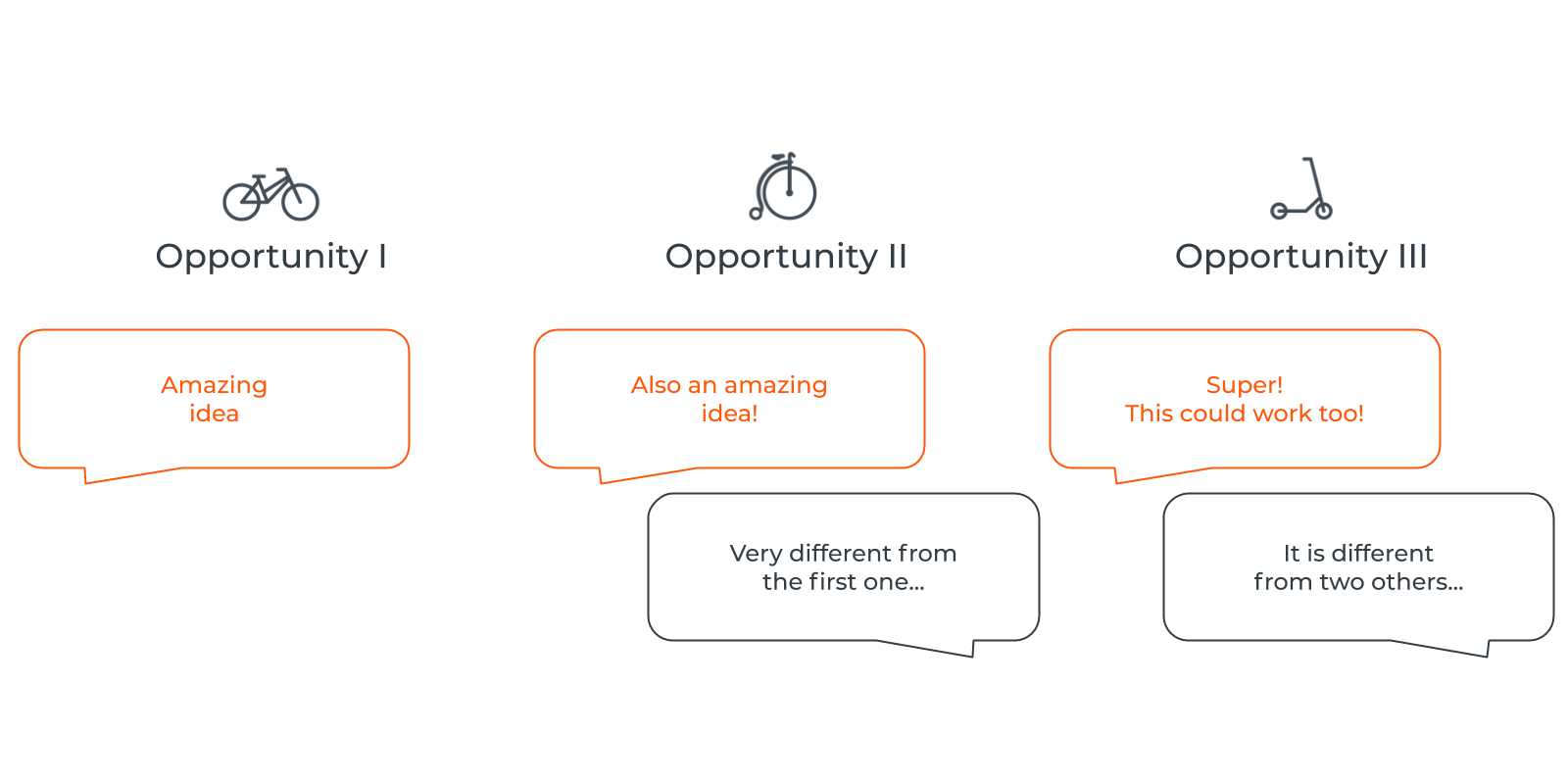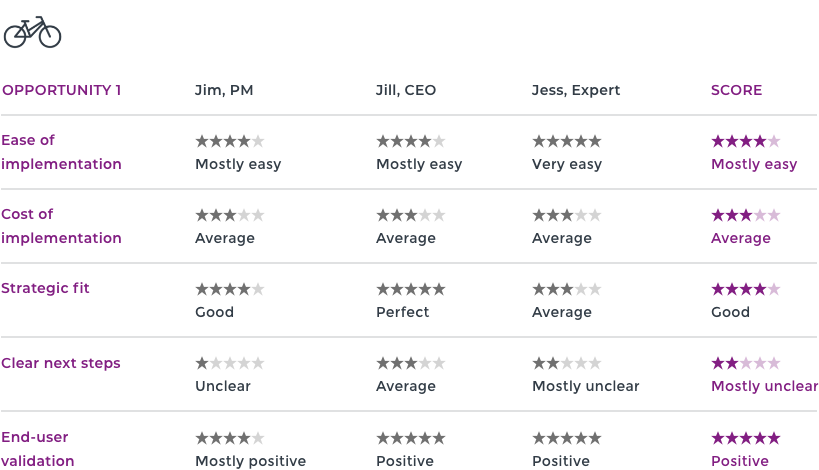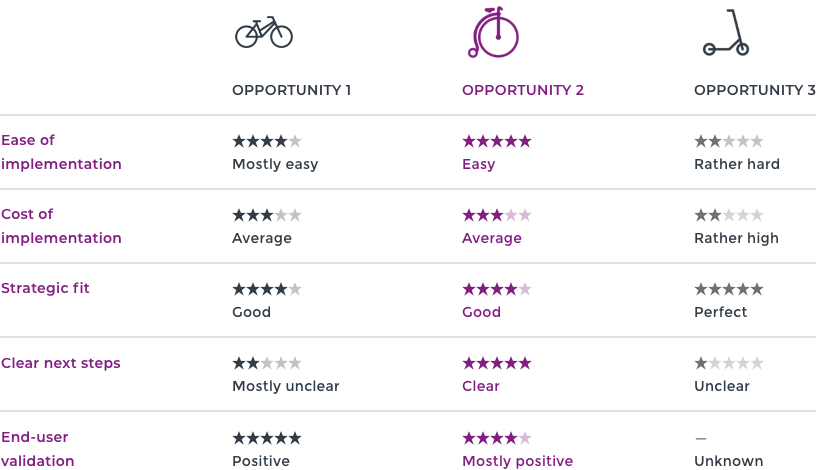As an innovation leader, you often face situations whereby choosing a certain track yields several opportunities. In such moments, it can be difficult to choose which of the ideas to take forward first, and it may prove especially challenging to get your team on-board with your choice. In this article, we will look at one of the prioritization methods that we recommend to our clients.
As an innovation leader, you often face situations whereby choosing a certain track yields several opportunities. In such moments, it can be difficult to choose which of the ideas to take forward first, and it may prove especially challenging to get your team on-board with your choice. In this article, we will look at one of the prioritization methods that we recommend to our clients.
Getting out of strategy development sessions with your team, you are likely to be experiencing this:

1. Set evaluation criteria
Let’s assume that you and your team have identified several tracks of further development. Your hard work paid back and all of them seem like they can yield profit.
In this case, we suggest you use 5-star rating systems to kick-off internal prioritization discussion. Keep in mind, that the final decision, of course, will require a lot more elaborate thinking. In this article, we are offering you tools to speed up communication during the first stage of the debate.
To start the evaluation, pick a very tangible parameter, that the whole team will be able to comment on. For example, in our practice, the ease of the implementation is most often a criterion that is easily discussed. We want to collect informed opinions (brainstorming based on the feelings and interests is a different exercise) to start setting our opportunities apart.
Continue by expanding your list of evaluation parameters. Setting the criteria that fits your project will be the key to prioritisation success.
The weights of your criteria would not be equal. Hence, you can spend time with your team coming to an understanding of which parameters should be taken as decision drivers. Depending on the situation, for example, “Strategic fitness” may have less value for the final prioritisation than other criteria. Let’s say you know that some of the opportunities do not fit the picture that leadership has drawn for the company. At the same time, you know that successfully executed opportunities within the budget that you already have are encouraged and will be scaled. In this case, “Cost of Implementation” and “End-user validation” might have a higher weight in your decision-making.
Establish a clear understanding and consensus on priorities within your team, before you can move on.
How hard is it to implement?
Opportunity 1:
★☆☆☆☆
Hard
Opportunity 2:
★★★★★
Low-hanging fruit
Opportunity 3:
★★☆☆☆
Noticeable effort needed
Some of the evaluation criteria that we suggest you consider
Ease of implementation
How hard will it be to implement
5 to 1 / Easy – Hard
Cost of implementation
How well does launching this opportunity and getting it market-ready fit our budget?
5 to 1 / Cheap – Expensive
Strategic fit
How well does this opportunity fit the trajectory set by the company leadership?
5 to 1 / Spot-on – Very far
Clear next steps
How ready are we to engage? How well do we understand all the process getting us to market?
5 to 1 / Planned-out – Unclear
End-user validation
What was prior user experience with similar products? Is there a clear demand for it?
5 to 1 / Positively validated – Unvalidated
2. Evaluate opportunities one by one
Once you and your team have agreed on evaluation criteria, it’s time for a high-five — the fundamental work is done. Now we suggest you rate each opportunity as a team using a whiteboard. In this exercise, you are looking for two things of equal value. Firstly, you now have a framework for a structured and informed conversation. You want to discuss opportunities to enrich the understanding of the subject across the group. Moving on to the decision making later, you will appreciate your team seeing the broader context. Secondly, of course, you end up with a rough score for each opportunity that will allow you to rank them later.
The best way of conducting this is letting everyone in the team to express their scores for an opportunity. To facilitate the conversation – log every opinion on the board and ask the evaluator to explain the score. By logging all the scores together with the team you can avoid the disagreements to arise. Once everyone has announced their vision of “Ease of Implementation” — see if you can come to a joint score based on what was said.
In most cases, there will not be any disagreements. However, at times you may notice that opinions are being held back. It is important to hear from the delivery and execution teams as much as from the company leadership. We encourage you to give an equal right of voice to the CEO and PM in this discussion. Some crucial procedural setbacks might not be visible for the leadership and can sink your innovation if not voiced early enough. At the same time, there might be the strategic value of a particular decision that has not yet been clear to mid-management.
If you think your team has not yet reached the stage when you can have this conversation — drop a message to us. At Vertical, we held workshops for change management many times and we will find the path that works for you.

3. Rank opportunities by comparing score-cards
As promised, after setting the criteria the work will only get easier. The next step after scoring each individual opportunity is comparing them side-by-side. This final exercise results in the team’s decision to pursue opportunities in a specific order (or to pursue a single one that looks the most rational).
Make sure to set a clear end goal for this discussion. For example, “Today we need to decide which one of these opportunities is going to become our priority in the development for the next 3 months.” This goal should be announced to the team before ranking, and you can return to it again if the focus of discussion shifts.
Usually, facilitating this step does not require specific skills. The scores should speak for themselves. Use your notes from the earlier discussion to give a summary of the pros and cons of each opportunity.
We recommend first deciding on a clear-winner or a clear-no-go. In most evaluations, the edges are usually very well defined by the scores.
The final scoreboard that you will have in front of you should help notice the differences across key parameters that you set earlier. If you did risk analysis, market studies, or any other fact-based research on these opportunities – it’s a perfect place to surface it on the same board.

The final decision should be framed in accordance to the culture of your organization. In some companies, the consensus is required. Others would prefer bringing the outputs of such workshop to the board to get the second opinion before any decision is made.
Whichever practice applies to you – we recommend documenting the outputs in a single document that can introduce a reader to the context of the decision that your team suggests. Such document can come especially handy if you need to pitch for additional innovation funding internally.

